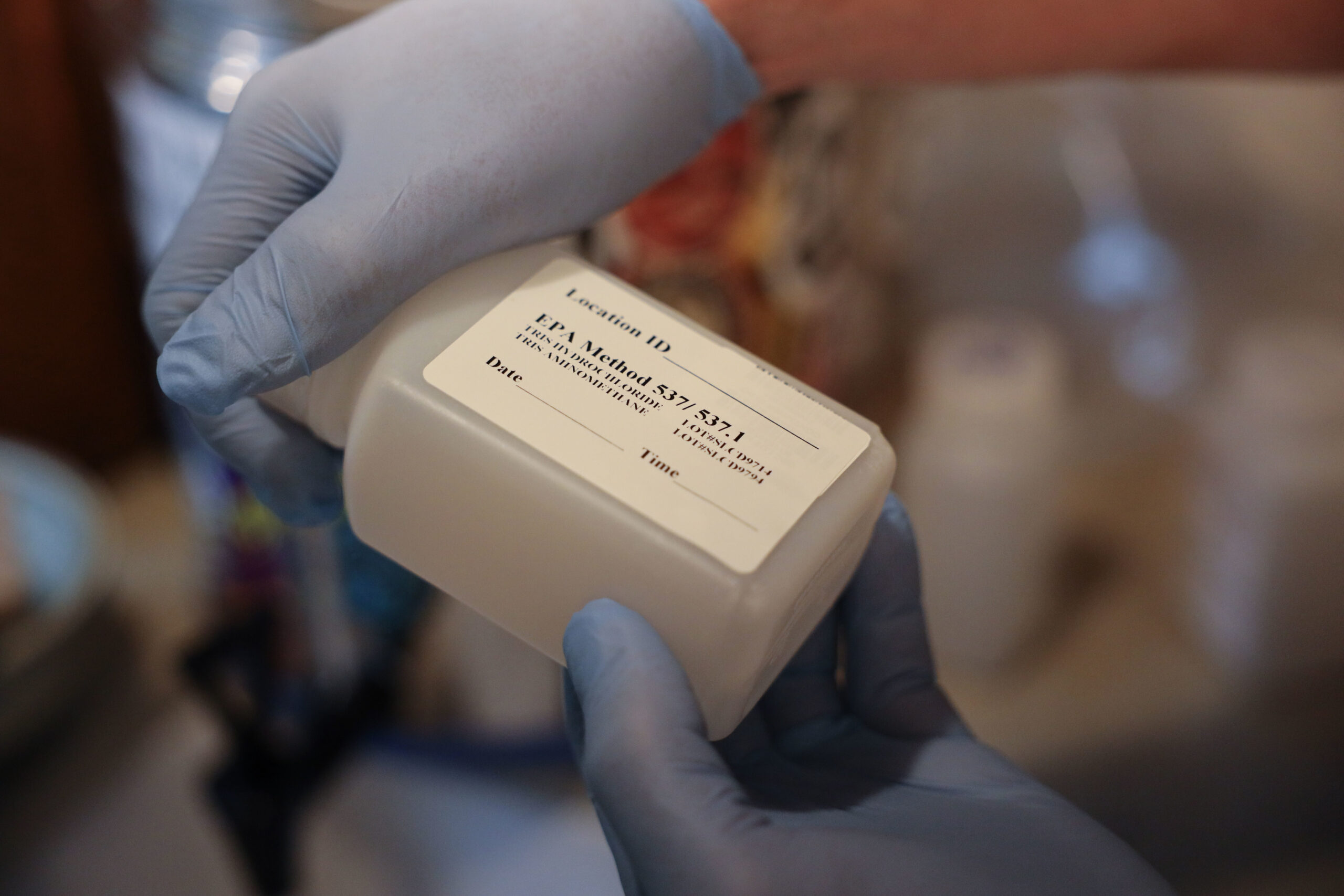Wisconsin will likely see its first standards for so-called forever chemicals known as PFAS now that Wisconsin Republicans have posed no objections to the rules.
An aide for Republican Sen. Steve Nass, who chairs the Joint Committee for Review of Administrative Rules, told the Associated Press Monday that the committee would allow the Wisconsin Department of Natural Resources to implement the proposed standards.
PFAS, or perfluoroalkyl and polyfluoroalkyl substances, are a class of thousands of synthetic chemicals found in firefighting foam and everyday products like nonstick cookware and stain-resistant clothing. Research has shown links to serious health effects that include increased risk of kidney and testicular cancers, thyroid disease and fertility issues. The chemicals have also been tied to reduced response to vaccines.
Stay informed on the latest news
Sign up for WPR’s email newsletter.
Elected officials, environmental groups, residents, industry and water associations have been at odds over how to regulate the chemicals and at what level. As state standards move forward, they will bring new testing requirements while federal regulators are updating their health advisories for the chemicals.
What PFAS standards are set to take effect?
In February, the Wisconsin Natural Resources Board declined to adopt the state’s recommended groundwater standard of 20 parts per trillion for the chemicals. But the board approved a drinking water standard of 70 parts per trillion for two of the most common PFAS chemicals: PFOA and PFOS. That mirrors a 2016 health advisory level set by the U.S. Environmental Protection Agency. However, the EPA released new health advisory levels Wednesday that are thousands of times lower than the state’s new standards.
The board also approved the DNR’s proposed threshold of 8 parts per trillion for PFOS in all surface waters with limited exceptions. For PFOA, the DNR is recommending a standard of 20 parts per trillion in waters deemed public water supplies and 95 parts per trillion for all other surface waters.
Where do groups stand on PFAS standards?
Water and industry groups had urged the DNR to wait for federal standards for drinking water rather than proposing statewide limits on PFAS.
Wisconsin Manufacturers and Commerce said Tuesday it didn’t raise any issues with the standards to the Legislature’s joint rules committee. The state’s largest business group said in February that the DNR had authority to set the drinking water standard for PFAS at 70 parts per trillion.
Water groups say they were seeking consistency in implementing rules rather than a patchwork of regulations. The state’s drinking water standard for PFAS would be far less protective than the EPA’s latest advisories. On Wednesday, the EPA updated its health advisory level of 70 parts per trillion to interim levels of 0.004 parts per trillion for PFOA and 0.02 parts per trillion for PFOS.
“EPA is issuing interim updated health advisories for PFOA and PFOS in light of new scientific information on these chemicals’ health effects. These interim health advisories will be in place until EPA’s forthcoming PFAS National Primary Drinking Water Regulation is in effect,” the agency said in a fact sheet.
The advisories are unenforceable, and the federal agency expects to set drinking water standards for the chemicals next year.
Water systems will comply with the DNR’s rule, according to Lawrie Kobza, legal counsel for the Municipal Environmental Group-Water Division.
“They clearly will do that,” Kobza said. “And when and if EPA comes out with a rule — which they’re expected to do — if it’s lower than what DNR has, they’ll comply with that.”
Kobza expects the DNR will provide guidance to water utilities on testing. She said one question is whether state regulators will require systems that have already sampled for PFAS to test their water again.
Water groups say utilities are in a difficult position with understanding an emerging contaminant and its impact on public health. They note water supplies are already trying to manage contamination from lead, nitrates, and other pollutants.
Environmental groups and residents of PFAS-polluted communities say state standards are sorely needed to protect public health and the environment. Those groups include Midwest Environmental Advocates, Clean Wisconsin, Sierra Club of Wisconsin, and Wisconsin Conservation Voters.
“These PFAS administrative rules are a significant step toward making sure all Wisconsinites have access to clean, safe drinking water,” Kerry Schumann, executive director of Wisconsin Conservation Voters, said in a statement Tuesday.
What systems will have to test drinking water for PFAS?
The DNR has said sampling for PFAS is required for community water systems, as well as non-transient non-community systems. They include systems that serve cities, mobile home parks, apartment complexes, businesses and schools.
When will PFAS standards take effect and testing begin?
The new standards could be published as early as July once they’re approved, according to the DNR. The agency said in a May 26 meeting of its Drinking Water and Groundwater Study Group that sampling requirements for drinking water will be implemented in phases based on the population served by water systems.
The largest drinking water systems, those that serve 50,000 people or more, could be required to start testing as early as this November. Some of those systems have already begun testing in cities like La Crosse, Madison, Milwaukee, and Eau Claire. Systems serving between 10,000 to 49,999 residents would begin testing three months later. Public water supplies serving less than 10,000 people would be required to test three months after that or 10 months after the rule becomes effective.
How often will systems have to test?
Initial testing will take place quarterly for systems that detect PFAS levels. The DNR can allow for a waiver of quarterly sampling if no traces of the chemicals are found. Those systems could be allowed to reduce monitoring to every three or every six years, according to the agency.
If the chemicals are detected, systems will have to conduct more frequent testing for PFOA and PFOS. The agency has previously estimated that only 26 water systems would exceed the DNR’s proposed standard of 20 parts per trillion.
What happens if PFAS is found?
Water systems may have to drill new wells, abandon existing wells or install treatment if levels of the chemicals require treatment.
That is a big concern for smaller water systems that serve communities of less than 10,000 people, according to Chris Groh, executive director of the Wisconsin Rural Water Association. He said it could cost around $1.5 million to drill a new well to replace any contaminated water supply.
“It’s going to be it’s going to be a hard time to comply as far as expense. Most cities are going to be limited as to what they can do right away,” Groh said.
How much could it cost to address PFAS?
For drinking water, the DNR estimated it would cost businesses and local governments about $5.6 million in the first year and an average of $3.9 million annually to implement its proposed standard of 20 parts per trillion. That figure may be smaller with the less restrictive standard of 70 parts per trillion although business groups have argued the DNR underestimated those costs.
Under its recommended threshold, environmental regulators expected nine systems would likely exceed standards and resort to treatment systems that could be financed through the state’s Safe Drinking Water Loan program. Those costs were expected to run around $35.2 million over two decades.
“Everybody should be a little bit concerned about the costs because the costs will be passed on to ratepayers — maybe not the full cost,” said Toni Herkert, government affairs director for the League of Wisconsin Municipalities.
She noted the DNR is receiving an additional $142 million under the bipartisan infrastructure law this year for the state’s revolving loan funds to address water challenges like PFAS and lead contamination. The EPA is also inviting states to apply for the first $1 billion of $5 billion in grants provided to address PFAS under the infrastructure law. Wisconsin expects to receive more than $800 million under the law to provide loans and grants to communities seeking to limit and address exposure to the chemicals, according to the DNR.
The DNR has said addressing PFAS pollution could save hundreds of millions of dollars in avoided health care costs that stem from low birth weights and hypertension by reducing PFOA exposure.
What about surface water standards for PFAS?
For surface water, the agency estimates the maximum cost to meet the standard each year would be around $4.8 million.
Regulators expect 48 small businesses that include paper companies, metal finishers and chemical manufacturers would see roughly $2.1 million each year in added costs.
The DNR will require PFAS testing of discharges from wastewater and industrial facilities to determine whether they’re meeting surface water standards for the chemicals. If facilities exceed standards, the agency will work with permitted facilities to reduce PFAS to avoid costly treatment. Those facilities will have up to seven years to implement plans to minimize PFAS levels.
Editor’s note: This story was updated Wednesday with information about the EPA’s latest interim health advisory level for PFAS chemicals.
Wisconsin Public Radio, © Copyright 2025, Board of Regents of the University of Wisconsin System and Wisconsin Educational Communications Board.





